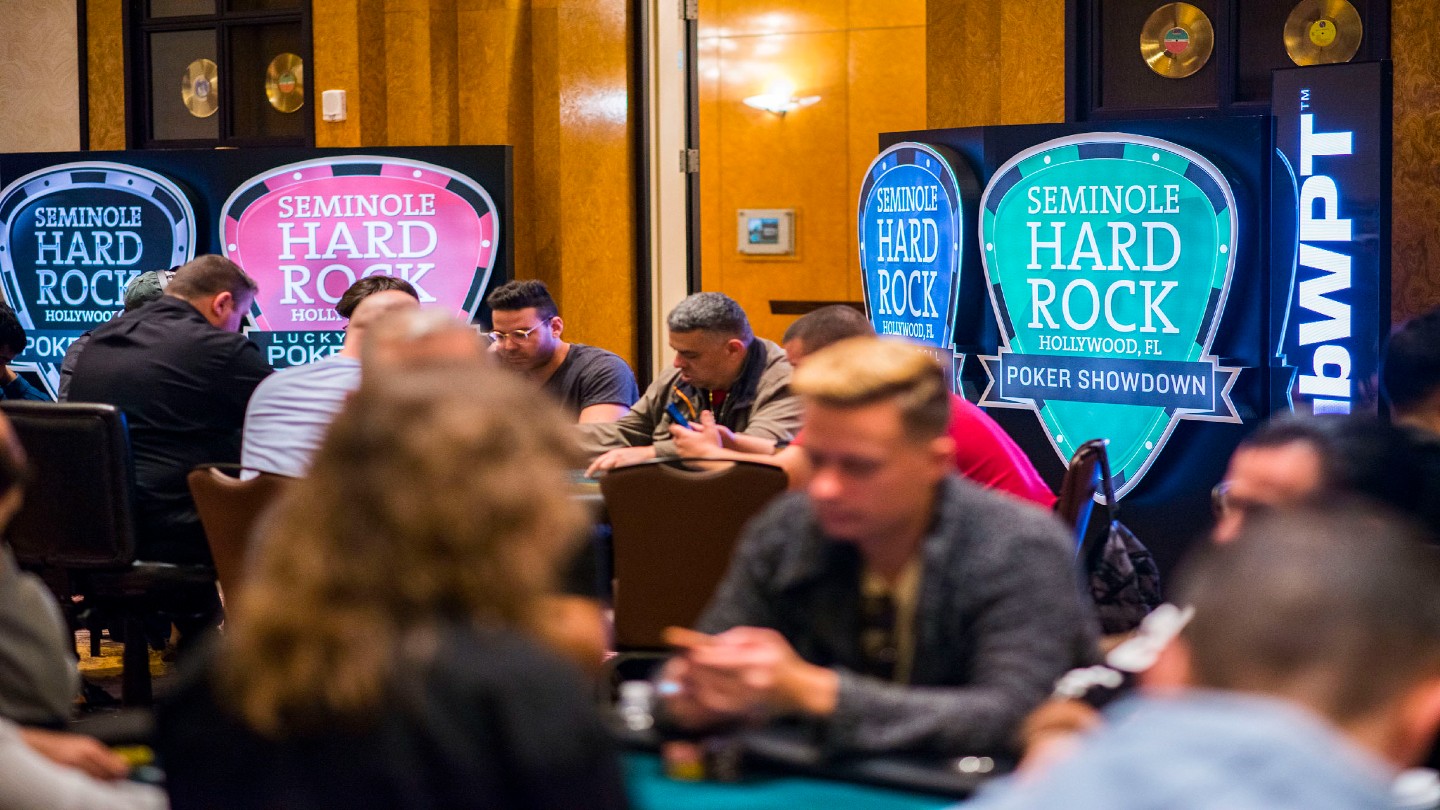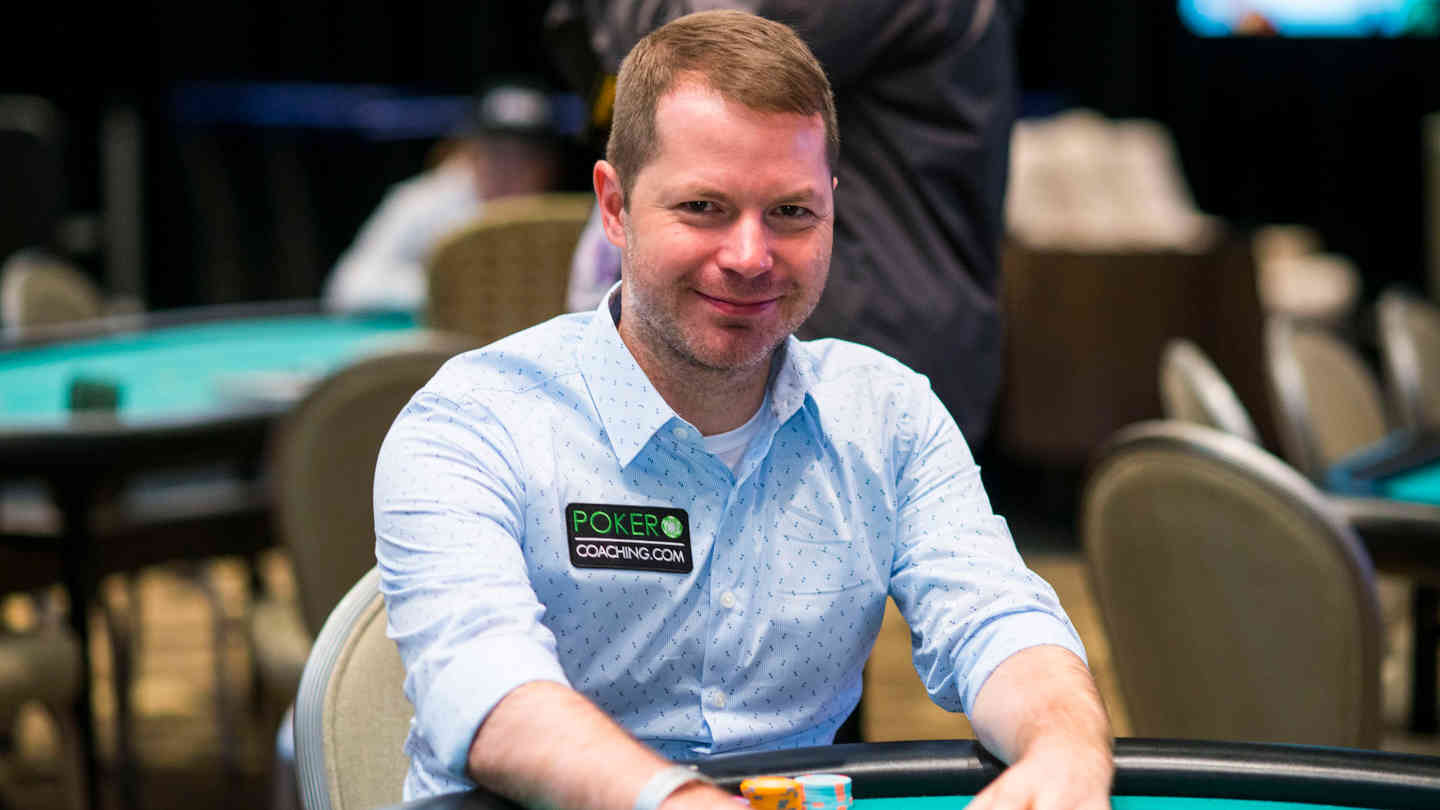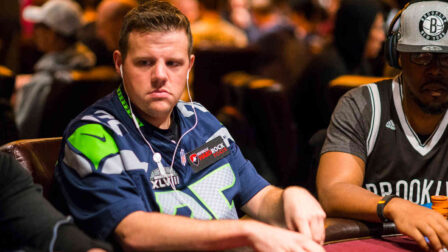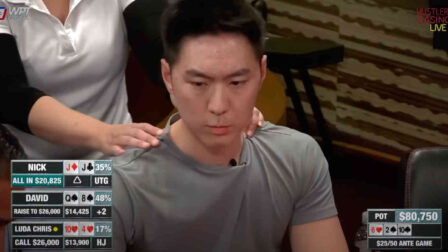Continuation Bet: How To C-bet Like a Boss And Win More

18 minutes
Last Updated: March 19, 2024
The correct continuation betting strategy is probably one of the first things you need to learn after mastering preflop play in poker.
Since this is one of the most common situations, you should learn how to approach it and avoid making costly.

The good news is that it is quite easy to learn effective strategies, which enables you to win more money by choosing the right hands to make a continuation bet.
Therefore, I will go over the most important betting and barreling concepts, which will help you to choose the right poker hands and spots to c-bet.
Table of content
- GTO vs exploitative play
- Know why you're betting
- Playing on various boards
- IP and OOP play examples
- Continuation bet sizing
GTO AND EXPLOITATIVE STRATEGIES
Like I covered in my detailed article GTO poker vs. exploitative play, you need to understand when to apply these different concepts to get the best results, and if you have not read the article yet, I highly recommend doing it.
Nevertheless, you have to distinguish you are up against a recreational player or a solid opponent and change your strategy accordingly.
You need to understand that you just cannot be c-betting the same ranges vs. different players and be sticking to one strategy all the time.
Therefore, you can and should quickly figure out the type of your opponent using the right poker stats or even with the help of some poker tells. So when you know your competition, you can build the best approach to beat it.
Against regulars and all tough players in general, you will be much better sticking with GTO strategies and trying to balance your ranges. Otherwise, you could end up having some problems against good opponents.
However, versus weaker players, exploitative strategies work much better, and it is true for continuation bet as well.
When you are up against a weaker player, you should try to identify mistakes and act accordingly.
- If they are folding too much, you should be barreling with almost all of your bluff, at the same time checking some medium-strength and made hands to let them bluff.
- On the contrary, if they tend to call nearly all of their range, you should be checking those weak hands and instead, c-betting all medium and strong holdings to get extra value.
Most of the time, you should be making that c-bet more often versus a recreational player and not try to balance your ranges at all.
It is not enough to know that you should be betting more hands. It is critical to understand which hands you should be choosing to make continuation bets more often and, most importantly, what you are trying to achieve by doing that.
KNOW WHY YOU C-BET
Without understanding and answering this question, you will be randomly firing bets and, most likely, not achieving results that you want.
I have seen this hundreds of times from my students.
Players tend to automatically c-bet, knowing that it can be profitable and not even think about alternative lines, which could make much more money in the long run.
Times, when you could be raising almost any two cards and then firing continuation bet on every single board, is gone and will never come back.
Now you have to build better strategies, understand how to balance your value to bluff ratio and which hands to check. Otherwise, you will not get the results that you want.
Therefore, when you have a chance to make a continuation bet, you should answer yourself what you are trying to achieve with it.

Without understanding the answer, you will likely end up just clicking buttons, which is not a winning strategy. So when deciding either c-bet or not, answer those few simple questions, and you will have a clearer picture:
- Are you betting for protection, value, or bluffing?
- If you value betting, can your opponent call you with weaker holdings, or maybe it is better to check and let him bluff?
- If you bluff, you want to make sure that he can fold better hands than yours. Otherwise, you are just wasting your hand and probably should check.
- How many streets are you planning to barrel? In most cases, the answer to this question will help you determine the best course of the whole hand.
While you can have a lot of fun firing some games in the Casoola casino, making decisions in poker requires more thinking, and answering these simple questions will help you understand if making a continuation bet is a better option than checking.
CHECKING Instead of C-betting
The same thought process goes for checking as well. You need to understand the reason behind the play and what you are trying to achieve.
Apart from the times when you are just giving up with the hand due to the bad board or unfavorable situation, you should know why checking is better than a c bet, and only then make the play.
To illustrate what I mean, I will take an extreme example to make it very clear. Let us say you open JJ on the BTN, BB calls, and you see a flop of J22. BB is going to check his entire range, and you face a decision to c-bet or to check.
Clearly, the latter option is superior here for several reasons:
- The board completely missed the big blind’s range, and if you choose to c-bet, he will likely fold the majority of the time. Not something you want to see after flopping such a huge hand, so you should check this hand to trap and continuation bet with many weak holdings.
- Holding pocket jacks, you block his possibilities to have a Jack himself because there is only one left in the whole deck, so your opponent is quite unlikely to have it. Even when he does, you will likely get some money in no matter what runout comes, so you are winning much more by checking compared to continuation betting here.
- When you check, you let your opponent improve his hand. Even if he has a trash hand such as 76o, which he would snap fold to any bet, if he hits that 7 or 6 on the turn, you are surely getting some money from him. Therefore, giving your opponent a chance to catch up where he has close to zero chances to outdraw you is always a good idea.
- Even if your opponent misses on the turn, he will have the opportunity to bluff and will choose that option a lot of the time. Thus, it adds some additional value compared to c-betting.
- There are no scary cards for you, so checking is very safe, and as you see, you are not reaching much by making a continuation bet in this spot.
Another significant benefit from checking these strong hands in poker is that you can also check some total air and bluff it later on because you will have some value holdings to go along with it.
Thus as you can see, all of the arguments are for checking and none for c-betting in this spot.
It is just one example, how you can break down different boards and run-outs to make optimal decisions quickly.
Remember that every single scenario could be analyzed similarly, and understanding what you can reach with a continuation bet or by checking will help you to improve a lot.
Continuation Bet on Different Boards
Your c-bet strategies will vary on different board textures, and it should be the most important factor, which you take into consideration while making the decision.
Well, not as much the board itself, but how your whole range hits the board and who has the advantage.
To figure this out, you can play with Poker Equilab or other similar poker tools to see who is a favorite in a particular spot.
As a rule of thumb, you will be c-betting more on dry boards because it will likely miss the caller's range, and have to bet less on connected ones because your opponent is much more likely to have a piece of that and call or even check-raise as a bluff.
Understanding the Range Advantage
While it is pretty much impossible to cover every possible scenario you’ll come across during your poker career, there is a way to improve your c-bet strategy significantly. To achieve the best results, you should be thinking in terms of ranges or, more specifically, in terms of the range advantage.
To apply this approach, you need to master preflop ranges, as I’ve already mentioned earlier in this article.

Knowing what types of hands are more likely to be in your and your opponent’s range can be very useful when constructing your c-bet strategy across different boards.
The best way to explain this point is by looking into some examples.
Let’s say you open from under the gun, and the big blind calls your raise. The fact you’re opening from an early position means you’ll have many more strong hands in your range, i.e., big pocket pairs, strong aces, and some combos of high cards.
Depending on your particular strategy, you might have a few more hands that don’t belong to this category, but your overall range will look something like this.
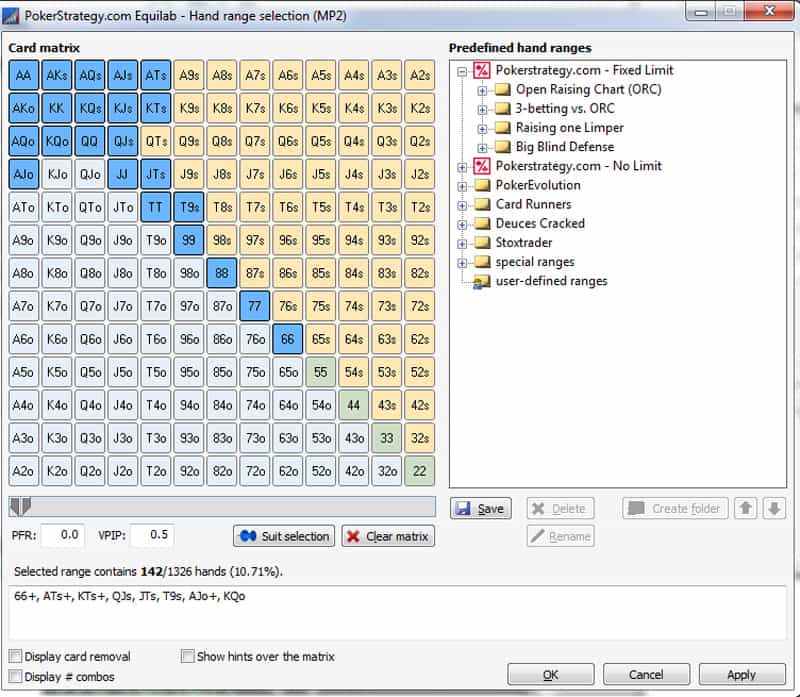
Provided your opponent is a competent player who understands you’re not randomly opening Q8o from UTG, you’ll have to tailor your c-betting ranges accordingly. On a board containing low or middling cards, you won’t be able to represent many strong hands credibly.
For example, if the flop comes 5s 8s 4h, there aren’t very many strong hands you can have. At the same time, the BB player has quite a few hands that will interact well with this particular texture.
So, you do not have range advantage here, as your opponent could have way more made hands like sets, two pairs, or even a straight.
By the same virtue, if the flop were to come Ah Qs 8d, you would have a significant range advantage. Given the fact your opponent didn’t 3-bet, you can discount a large percentage of their strongest hands. Hence, even the hands that do catch a piece of this flop won’t be able to take too much pressure.
Of course, opening ranges change depending on your position, and they aren’t set in stone as different players play somewhat different strategies.
However, understanding the overall principle of the range advantage is very important when deciding whether to c-bet and when defending against a c-bet.
You should spend some time analyzing different boards to build a good understanding of which spots favors your range and when you should c-betting and barreling as a bluff more often. Get tracking software to see how your opponents play and make your decisions easier.
IP and OOP Continuation Betting Strategies
You need to understand the difference between IP and OOP play. Your c-bet ranges need to change based on that, and you need to play it a bit differently, to take max EV lines.
If you have a position on your opponent, it is much easier to realize your equity with the hand, and you are guaranteed to see the turn if you check back.
While OOP, if you check, you could be facing a bet on the flop, turn and river from your opponent and have one more street to bluff catch, which makes your life much harder.
Therefore, you need to check stronger hands OOP instead of making a continuation bet with all of them. Otherwise, it will be tough to defend against aggressive opponents, and people tend to bluff a lot versus missed c-bet.
When you are out of position, your c-bet range should be much smaller, and as we said before, you should check many reasonable strong hands to protect your holdings and have a chance to bluff catch.
Otherwise, you will put yourself in the spot where you check just average strength and weak hands, or poor draws such as one to an inside straight. In this case, you will be able to call one or two bets but will have to fold on the river in most cases making you very vulnerable against any thinking opponent.
It is a vital part, and checking stronger hands is not enough. You need to understand how to deal when facing aggression, which hands to check-raise and when it is better to bluff catch by just calling.
C-betting in Position
Playing in a position is generally much easier, and you’ll have a much better time with your continuation bets when IP. However, you still need to have certain strategies, especially against thinking players who will take advantage of your tendencies.
The good place to start is thinking along the line of ranges.
These will help you avoid certain situations where your positional advantage won’t be enough to overcome their range advantage.
Beyond that, you can group your hands into four main categories:
- Strong hands you can always bet for value/protection
- Marginal hands you can bet or check, protecting your range
- Bluffs with some immediate or backdoor equity
- Weak hands you’ll want to check and give up on the turn unimproved
Unless you have the board completely locked up, like in the case of the J22 example we covered before, you’ll usually want to bet with your strong hands. You’re doing this to build the pot and get some value while also protecting against any potential draws your opponent might have.
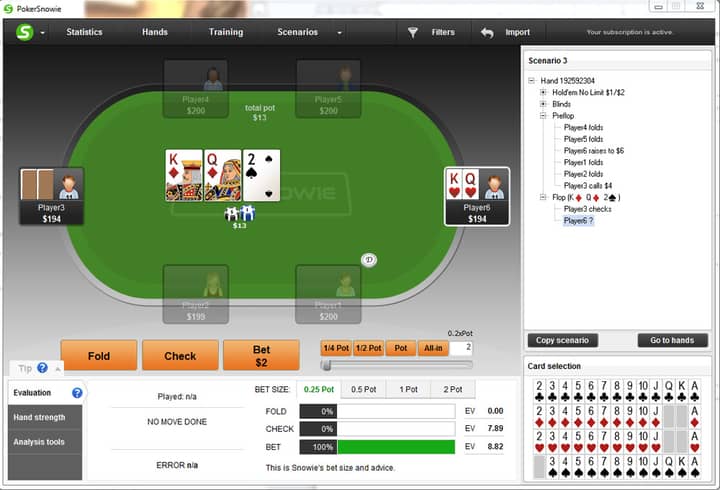
Get PokerSnowie FREE Trial and try it yourself!
As you can see, c-betting this hand 100% of the time. Although your hand is very strong, you want to start building the pot and getting the value on the flop as later streets can bring cards that will make it harder for you to bet or for your opponent to call.
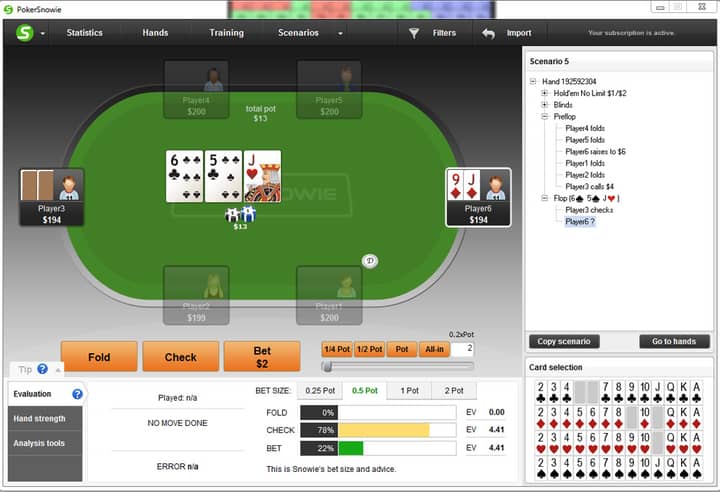
In this scenario, you have a fairly strong hand but not necessarily the one that you’ll be able to bet on multiple streets. This hand belongs to the category of marginal hands that you’ll want to check back some of the time to protect your range.
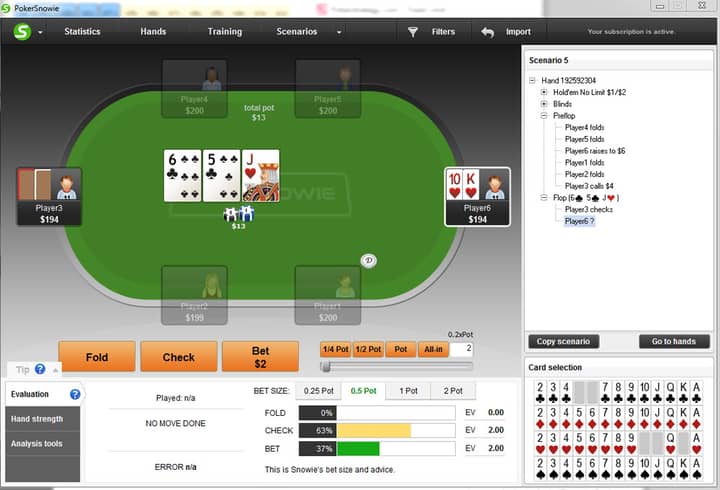
This hand is a good example of a spot where you’ll want to balance between c-betting and checking back when you don’t have any immediate draws. At the moment, your hand isn’t strong, but many good turn cards can put you in a spot where you’ll be able to continue barreling.
So, you shouldn’t be auto-checking in these spots. Instead, you can balance between betting and checking with different plans for different turn cards.
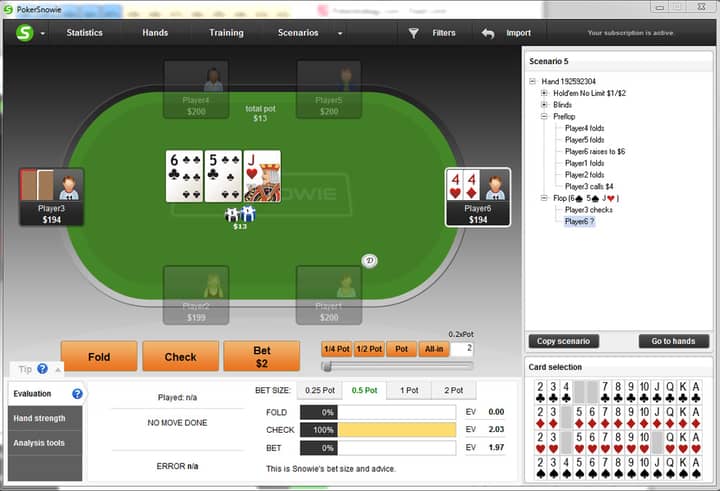
Finally, this is an example of a hand PokerSnowie suggests to give up. We have no range advantage on this board, our hand is just weak, and we don’t have any blockers.
Checking back and hoping to get a good card on the turn or go to a free showdown is the best course of action. Unimproved, you should be looking to fold to any aggression from your opponent.
These are just a few examples from the countless pool of possibilities. However, these should give you a pretty good idea of the baseline thinking you should adhere to when considering whether to c-bet or not when you are in position.
These suggestions presume that the player on the other side of the table is a thinking player that won’t just let you run over them or make random calls with any two cards.
C-betting Out Of Position
Your general approach when out of position will be to play tighter. In marginal spots, you should lean more towards checking because you won’t have the benefit of seeing what your opponent does on the turn, for example.
One very interesting thing to note is how your check-calling range will expand significantly.
This doesn’t seem very intuitive at first, but you’ll want to get value from your strong hands, and the best way to do it is by checking some of them and letting your opponent bluff.
By doing that, you’ll also be able to get away with checking some of your weaker holdings/draws without letting the IP player bet and get you off your hand every time.
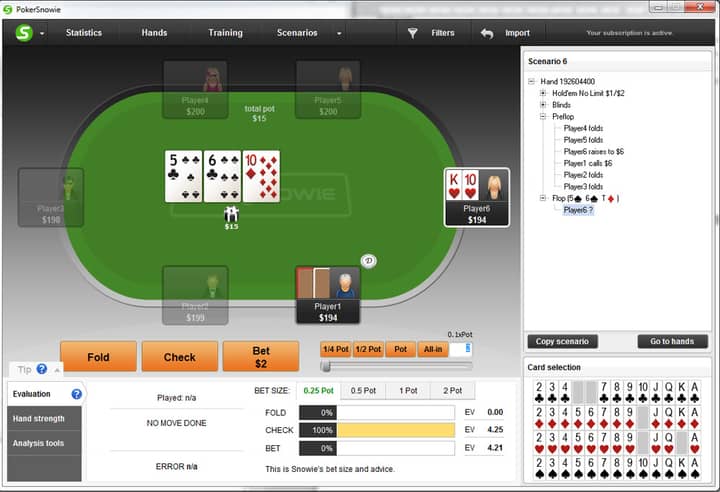
In this scenario, you have a very good hand – top pair with the second kicker. The reason you’re checking is to let your opponent try and bluff you. It may seem like a risky move as they can check back and get a free card, but having such hands in your checking range is vital for several reasons.
If you’re only checking when you miss and have no strong hands in your range, an observant opponent will bet every time you check to them and win the pot pretty much 100% of the time.
If they know you could be checking intending to call or even check-raise, they won’t be as inclined to try and bluff you.
Continuation BET SIZING FOR MAX RESULTS
One of the hardest things to master in poker, yet a critical one. It is close to impossible to analyze all of the different scenarios and possibilities in a single article. Therefore, you should look at some professional training sites like Upswing poker lab or Pokercoaching to deepen your understanding.
However, it is essential to understand at least the most crucial points not to make huge mistakes when continuation betting. Let us divide all the boards into two parts to make it as simple as possible – dry and connected ones.
When you choose to c-bet on a dry board, you should never bet more than half of the pot and could go with even smaller sizing in most cases. The reason is simple; you will achieve the same results with a small sizing.
- Betting small enables you to bluff with more hands and cheaper
- You protect your stack when your opponent does have a strong hand and lose the minimal amount
- You force him to continue with weak holdings and can easily make him fold on later streets
However, on connected boards, everything is the contrary, and you do not want to bet small and give your opponent correct odds to call with his draws to outdraw you.
Therefore, you should be betting at least two-thirds of the pot when you choose to c-bet and putting your opponent to the test.
Distinguishing bet sizing based on board texture is crucial, and if you do not know how to implement advanced techniques live over betting or under betting to manipulate your opponent range, stick to the above-mentioned continuation bet strategies, and you will be up for the good start.
Bet Sizing – Examples
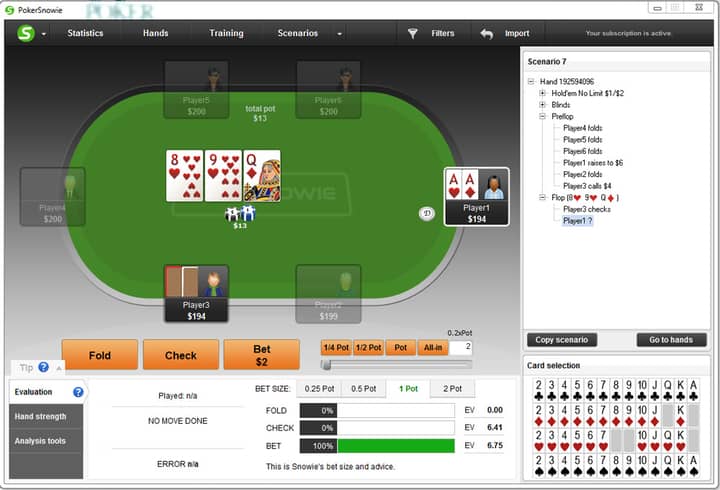
Here, PokerSnowie suggests firing a continuation bet of the size of the pot. You’re likely to have the best hand at the moment, but it’s a dicey board. Many turn cards could potentially improve your opponent’s hand. So, you want to bet big to protect your holding and put pressure on any draw they might have.
It is not a scenario where you want to get tricky by checking back or betting small. While a big bet on the flop will polarize your hand, this is the best play you have.
The only time you’d consider checking here is against someone who you know is prone to bluffing and will likely start to barrel on the turn regardless of their holdings.
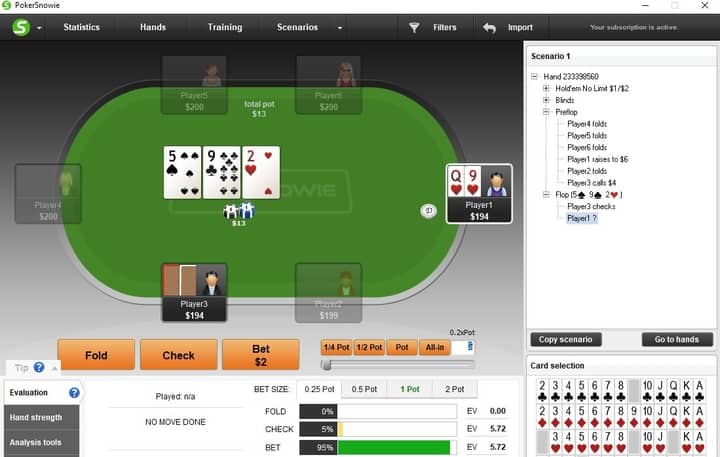
On the dry board, PokerSnowie opts to bet most of the time with a smaller sizing. As previously mentioned, this gives a lot of benefits for you and forces your opponent to continue with a wider range full of weak holdings.
This is simply the matter of maximizing your EV with the entire range. The BB player will fold all of the hands that don’t connect with the board and will be forced to continue with anything that has at least some playability.
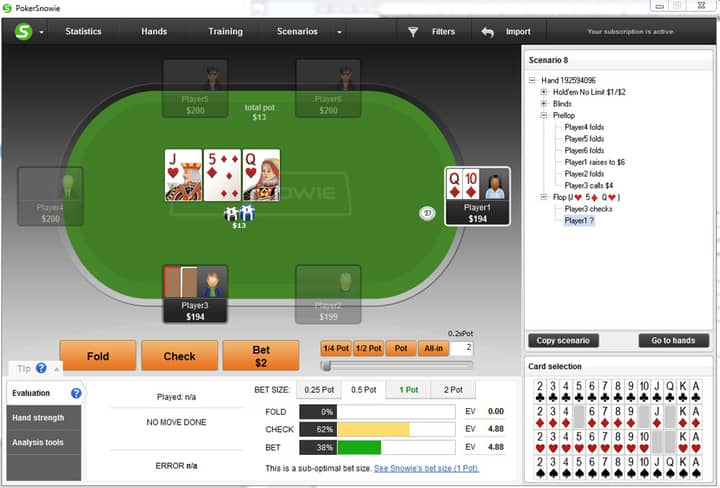
Get PokerSnowie FREE Trial and try it yourself!
In this scenario, Snowie prefers checking back as the standard line. However, if you were to fire a continuation bet, making it about half the pot is the best sizing. You have a fairly strong hand with some backdoor possibilities, so even if you face a check-raise, you’ll be able to continue when you make the half-pot c-bet.
While there is no simple strategy guide that will tell you how to size your c-bets in every possible scenario, these general tips and examples should give you a pretty good idea.
The main takeaway from this discussion is that you shouldn’t blindly stick to the same c-bet size no matter what.
While it may seem like a good idea as it makes you harder to “read,” it will cause you to miss out on EV in many spots or give your opponents great odds to draw out on you.
GROUPING C-BETTING AND CHECKING HANDS
As you see, there is a ton of information, which you need to take into consideration before making a c-bet. To make things easier, you can follow a simple system to make educated decisions.
I am talking about hand grouping. It enables you to put hands into different groups and quickly know either you should be c-betting or checking.
You can find more about it along with strategies for different boards, tips on how to adjust vs. various opponents, and much more in my coaching program or choose one of many available poker training options based on your game.
Whichever option you choose, keep working on your game, and you will learn how to make educated decisions and win more!
Summary:
- Understand what you are trying to achieve with your bet
- Plan in advance how many streets are you going to bet
- Check some strong hands to balance your ranges
- C-bet much less when you are out of position
- Vary bet sizing based on board texture and ranges, not your actual hand









